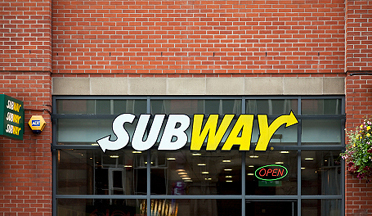 Subway is the second largest franchise food chain in the
world. The Subway growth model is one that defied the traditional fast-food
industry and has worked well in marketing the franchise. But a good part of
their marketing was not necessarily planned in the boardroom as much as it was
a grassroots effort from franchisees who were listening to their clients.
Subway is the second largest franchise food chain in the
world. The Subway growth model is one that defied the traditional fast-food
industry and has worked well in marketing the franchise. But a good part of
their marketing was not necessarily planned in the boardroom as much as it was
a grassroots effort from franchisees who were listening to their clients.
One of the first things that Subway did that helped them
become a national chain was to make it easy on their franchisees to go into
business. First, they put the store anywhere… and I mean anywhere! I remember
the first time I visited a Subway restaurant. It was in an abandoned gas
station along a stretch of interstate that sat across the street from a
McDonalds and Burger King. The only reason I tried it was because the drive
through lanes at the other restaurants were out to the street and I was in a
hurry. Subways began popping up all over the place: in big box stores, in strip
malls, in gas stations. Unlike other fast-food franchises who, at that time,
required a specially designed stand alone bricks and mortar building (in
McDonalds’ case, they owned the building and leased it to the franchisee), if
you could find your own space, you could have a Subway franchise. It was also
very low cost to set up and run a Subway. You needed a cooler and a bread
machine. Customer convenience was the hallmark of Subway. It seemed that
everywhere you turned, there was a new Subway opening up, making it easy on the
customer to choose them. They were in your neighborhood. You could get your
sandwich made anyway you liked it for the same price. Customer service was on
display right in front of you. If you wanted to add cheese to your sandwich, it
was included. If you wanted to load on the vegetables, no problem. Convenience
became the real key here.
Subway also made a big deal of their successes, although,
this did not come from the top down, but rather from the bottom up. Let me
explain. In the 1990s there was considerable pressure put on the fast-food
industry to make their food healthier, to post nutritional information, etc.
What the industry did about this was to ignore the problem. However, one
Houston franchisee came up with a special promotion. He invented the "7 under 6”
promotion. In other words, he promoted seven subs that had 6 grams of fat or
less. The idea caught on with other franchisees, including one in Bloomington,
Indiana. That was the store where a college student named Jared Fogle was
frequenting. He began a diet of low-fat Subway sandwiches. In less than a year,
Jared’s Subway diet (along with exercise – walking) helped him shed 245 pounds.
A franchise spokesman was born. Subway used the success of a common customer to
market the restaurant as a healthy alternative to other fast-food restaurants.
Any time you can distinguish yourself from the others, do
it. This is the real key to Subway’s rise past Wendy’s and Burger King to claim
the #2 spot in the fast food industry. They own the health-food crowd. They are
sponsors of weight loss TV shows. They market the evils of fryers vs. fresh
meat and veggies. The fryers used to thumb their nose at the pop health craze.
Now they are chasing Subway to get a piece of that market share back into their
stores.
In their book, Bottom-Up Marketing, Al Ries and Jack Trout talk about two key pieces of
marketing when you are trying to make a distinction between your company and
the competition. They talk about monitoring trends and finding a tactic to
expose the weaknesses of your competition within that trend. That is exactly
what Subway did with the health issue and their fryer competition. "A tactic is
a competitive mental angle. The best tactic to use is the one that strikes at
the weak point of your competitors in the mind of the prospect.”1 Do
you know what trends are happening with your customers? Do you know what your
competitors’ weaknesses are? Are you using your successes to gain a larger
foothold within your industry? If you don’t pay attention, you could find
yourself chasing the competition instead of them chasing you, just ask the
fryers.
_______________________________
1. Bottom-Up Marketing by Al Ries and Jack Trout. Penguin
Books Ltd. New York.
Starbucks Becomes No. 3 U.S. Chain, Passing Burger King and
Wendy's by Maureen Morrison, AdAge April 27, 2011
http://adage.com/article/news/starbucks-passes-burger-king-wendy-s-3-spot/227252/
Subway.com Jared’s Journey.
http://www.subway.com/subwayroot/freshbuzz/website/jareds_journey/default.aspx
Jared Fogle, NNDB. http://www.nndb.com/people/955/000044823
Photo by Adrian Beesley